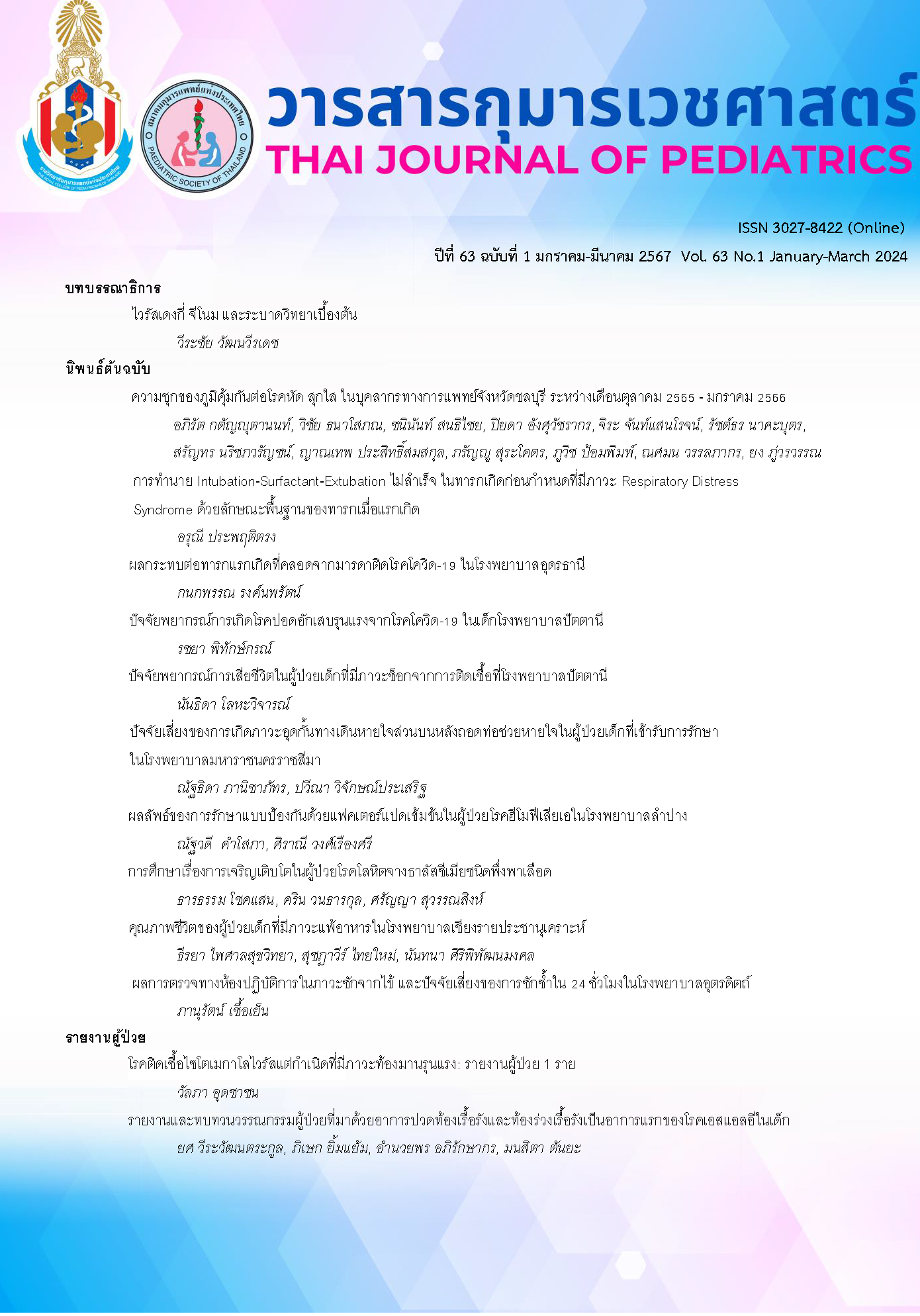Prognostic factors associated with mortality from septic shock in pediatric patients, Pattani Hospital
Keywords:
Sepsis, septic shock, child mortality, prognostic factor, metabolic acidosisAbstract
Background: Septic shock is one of the leading causes of death in children worldwide. Although there are diagnostic and treatment guidelines, the mortality rate of these conditions remains high.
Objective: To determine the prognostic factors associated with mortality from septic shock in pediatric patients.
Method: A retrospective study was conducted in the Pediatric Intensive Care Unit of Pattani Hospital. Patients aged 1 month to 15 years with a diagnosis of septic shock were enrolled between 1 January 2017 and 31 December 2021. The study compared survivors with non-survivors by t-test, Fisher's exact probability test, and multivariable logistic regression analysis.
Result: A total of 84 patients were enrolled in this study, 51 patients died during hospitalization. On multivariate analysis, the significant factors associated with mortality were 1. Progression of sepsis to septic shock within 7 days (risk ratio [RR] 5.59, 95% CI 2.07-15.09)), 2. Metabolic acidosis (RR 1.65, 95% CI 1.13-2.42)
Conclusion: Pediatric patients with sepsis should be closely monitored, especially within the first 7 days, and those with metabolic acidosis.
Downloads
References
Weiss SL, Peters MJ, Alhazzani W, Agus MSD, Flori HR, Inwald DP, et al. Surviving sepsis campaign international guidelines for the management of septic shock and sepsis-associated organ dysfunction in children. Pediatr Crit Care Med. 2020;21(2):e52-e106.
Limprayoon K, Phumeetham S, Saito N. Effect of the ‘SURVIVING SEPSIS CAMPAIGN 2012’ on mortality in the pediatric department of Siriraj Hospital. Southeast Asian J Trop Med Public Health. 2017;48:79-87.
Rusmawatiningtyas D, Rahmawati A, Makrufardi F, Mardhiah N, Murni IK, Uiterwaal CSPM, et al. Factors associated with mortality of pediatric sepsis patients at the pediatric intensive care unit in a low-resource setting. BMC Pediatr. 2021;21:471.
Phumeetham S, Preeprem N. Factors significantly associated with death among pediatric septic shock patients in a resource-limited setting. Southeast Asian J Trop Med Public Health. 2021;52:663-75.
Shah S, Deshmukh CT, Tullu MS. The predictors of outcome and progression of pediatric sepsis and septic shock: A prospective observational study from western India. J Postgrad Med. 2020;66:67-72.
de Souza DC, Machado FR. Epidemiology of pediatric septic shock. J Pediatr Intensive Care 2019;8:3-10.
Uppala R, Wongrat C. Mortality and predictive factors in pediatric severe sepsis and septic shock after implementation of Surviving Sepsis Campaign Guideline in Srinagarind Hospital. Srinagarind Med J 2020;35:404-9.
Yuniar I, Karyanti MR, Kurniati N, Handayani D. The clinical and biomarker approach to predict sepsis mortality in pediatric patients. Paediatr Indones. 2023;63:37-44.
Kaur G, Vinayak N, Mittal K, Kaushik JS, Aamir M. Clinical outcome and predictors of mortality in children with sepsis, severe sepsis, and septic shock from Rohtak, Haryana: A prospective observational study. Indian J Crit Care Med. 2014;18:437-41.
Branco RG, Garcia PCR, Piva JP, Casartelli CH, Seibel V, Tasker RC. Glucose level and risk of mortality in pediatric septic shock. Pediatr Crit Care Med. 2005;6:470-2.
Paudel R, Bissell B, Dogra P, Morris PE, Chaaban S. Serum bicarbonate: Reconsidering the importance of a neglected biomarker in predicting clinical outcomes in sepsis. Cureus. 2022;14(4):e24012.
Maitland K, Kiguli S, Opoka RO, Engoru C, Olupot-Olupot P, Akech SO, et al. Mortality after fluid bolus in African children with severe infection. N Engl J Med. 2011;364:2483-95.
Goyal P, Chandra D, Goel D, Kumar D, Kumari A, Prasad P. Predictors of outcome in pediatric septic shock: Experience from a tertiary care teaching hospital. Pediatr Rev Int J Pediatr Res. 2019;6:489-94.
Spitalnic S, Sidman RD, Monti J. Serum bicarbonate and anion gap cannot reliably predict elevated serum lactate levels. Ann Emerg Med. 2004 1;44:S54.
Downloads
Published
How to Cite
Issue
Section
License
Copyright (c) 2024 The Royal College of Pediatricians Of Thailand

This work is licensed under a Creative Commons Attribution-NonCommercial-NoDerivatives 4.0 International License.



